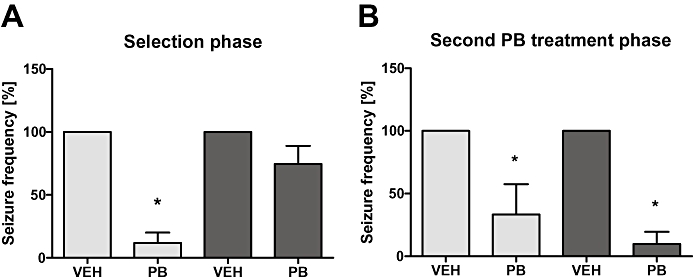Figure 3.

Effects of phenobarbital (PB) on spontaneous recurrent seizures in responders (n = 4) and non-responders (n = 4) epileptic rats (A and B). In this figure only those animals were included, that survived till the end of experiment. (A) Spontaneous recurrent seizures were recorded over a period of 16 days before onset of phenobarbital treatment (pre-drug control) followed by drug treatment for 16 days. Spontaneous recurrent seizures were continuously (24 h·day−1, 7 days·week−1) recorded in all eight rats over the whole time of this experiment. (A) illustrates the average of seizure reduction (mean ± SEM) in responders and non-responders during phenobarbital treatment in comparison with the vehicle (VEH) control period during the selection phase. Note the striking reduction of seizure frequency by phenobarbital in responders compared with non-responders. *Significantly lower than vehicle period. (B) Following a second vehicle control period of 7 days and constitutive application of celecoxib over 6 days, the effect of a 16 day phenobarbital treatment on spontaneous recurrent seizures was evaluated during the second treatment phase. (B) illustrates the average of seizure reduction (mean ± SEM) in responders (n = 4) and non-responders (n = 4) during this second phenobarbital treatment following after celecoxib pretreatment in comparison with the vehicle control period. Note that both groups of rats, responders and non-responders exhibit a significant reduction of seizure frequency by phenobarbital. *Significantly lower than respective vehicle period.
